Connie Bombaci's Blog, page 10
August 22, 2017
Living with our Beloved Deaf Dogs
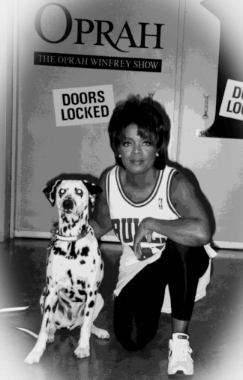
Hogan with Oprah Winfrey, 1996
With each event for my first-time book, Hogan's Hope: A Deaf Hero's Quest for Love and Acceptance, my sense of urgency to shout from the rooftops that deaf dogs are capable of being wonderful members of our families increases. I want the message to spread farther and faster than it is. But, I must remember that the world of we dog lovers has drastically changed from since 1993 when I first brought my Hogan home.
In October 1993 Hogan entered our home and changed my heart and the hearts of many others. Back then, I was warned about the "dangers of deaf dogs," told that deaf dogs need to be destroyed, and shunned among some of the other dog lovers. I am so glad that my heart told me otherwise and began reaching out on the Internet to find other families with deaf dogs. Being educators, my caring husband, Jim, and I didn't give Hogan's deafness much of a thought other than what adaptations need to be made for him to lead a completely normal life. It only seemed natural - Each one of our students had various needs and we merely changed things up to make it all work for the good of our students.
Before long, I began to receive questions from all over the nation, then around the world, about what we were doing and how we were doing it. I didn't give us any sort of self-proclaimed "pat on the back" - it's just what we would do for anyone who had a particular need and we didn't (still don't) deserve it. It was Hogan who was doing the heavy lifting and he held the light of hope out in front every step of every day.
So, we worked with our Hogan and began to go places to share our family and how we worked together as a family - a great big, loving family. Writers began to gather information and a lovely lady by the name of Susan came out with the first book. Yes!!! Deaf dogs were being accepted and folks began to reconsider their thoughts, misnomers, prejudices, and myths.
I must share with you all that we were blessed to have Dr. Nicholas Dodman, world famous Animal Behaviorist, enter our lives via a referral by our own amazing veterinarian, Dr. John Ouellette. Dr. Dodman, Hogan, and I worked on several issues not uncommon to both hearing and non-hearing dogs such as being a "Velcro" dog. Dr. Dodman was so impressed by Hogan that he included my pup in his book, invited us on the Oprah Winfrey Show with him, and went on the television show, Amazing Tails, together. Finally, Dr. Dodman honored me and requested that I write my thoughts on living with a deaf dog for Tufts' website, Pet Place. I have included it below and hope with all my heart that it reaches everyone who has a deaf pup. Living with a deaf dog is NOT difficult. Long dissertations aren't necessary. It's no different than living with a hearing dog. We just need to make the necessary adaptations so we all understand each other.
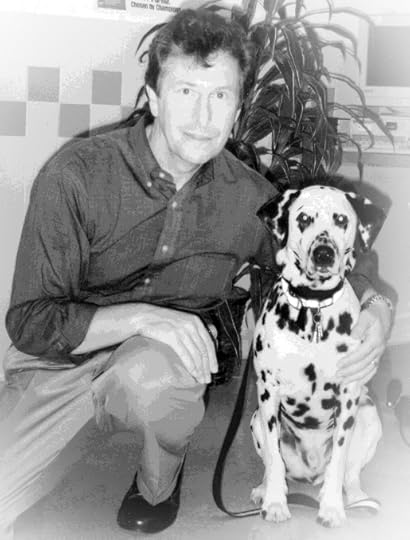
Dr. Nicholas Dodman and Hogan, Tufts University Foster Small Animal Hospital
Tips for Living with a Deaf Dog
Written by Connie Bombaci
Edited by Dr. Nicholas Dodman
Posted on Pet Place
“(There are) none so deaf as those who refuse to hear.”
(Adapted) Matthew Henry, Commentaries, (1708-1710)
“Who have eyes but do not see,
who have ears but do not hear”
Jeremiah 5:21
Adopting a dog into your family can certainly be an adventure. Diet, training, housebreaking and time are only a few of the considerations. Add deafness to the equation and many run for cover. A cloud of myth too often seems to hover over a dog who is found to be deaf. Some
claim that deaf dogs are dumb and unable to learn. Others maintain that they are difficult to train, moody and certain to be hit by cars. On the contrary, deaf dogs are lovable and intelligent animals who have the capacity to bring great joy and companionship into our lives. They are not in pain, nor do they need our pity. They are happy and can be socialized and trained, and like their hearing canine friends, they respond positively and with great affection when given regular and consistent doses of patience, understanding, and praise.
To begin, deafness may be the result of different reasons. Some dogs are born deaf because of their genetic makeup. Other dogs acquire deafness as a result of infection, toxicosis or old age. A thorough medical examination by a qualified veterinarian is always recommended to determine the cause, the extent, and any possible treatment. Whether the deafness is treatable or not, the bottom line is that your dog is capable of leading a full and enjoyable normal life.
Deaf Dogs: Communication is the Key to Success
Anyone acquainted with a deaf pup, child, friend, or relative knows well that establishing a solid method of communication is essential. By purchasing a pocket-sized handbook on American Sign Language (ASL), you do not have to know any ASL prior to adopting your deaf
pup. ASL is easy to use and convenient for several reasons. There are more people who know at least a few signs than you might imagine. That makes it possible for other folks to “talk” with your pup. Additionally, when you have to leave your dog with a sitter or the vet, all you have to
do is either leave the handbook with marked signs or copies of the most important signs. Your dog will then never be left in a totally “silent” world. Someone will always be able to communicate with your dog without a great deal of instruction, which could prove to be invaluable in the event of any sudden or emergency situations!
Start the same way that you would start with a hearing dog–simple repetition, patience, reward and lots of praise. The only difference in training a deaf dog is that you use your hands instead of the spoken word. Dogs are physical by nature s it will not take long before they begin to watch your hands intently for cues. You should begin with something that is a real attention grabber. “Cookie” is always a puppy pleaser. (Cookie = shape your right hand into the letter “C” and rotate the tips of the fingers on the flat palm of your left hand as if you were cutting out a cookie.) With your dog facing you, make the sign for cookie and then give him a delectable treat. Wait a few seconds and repeat. Once your pup puts together “cookie” and the reward, you will be off and running! Keep it simple and always use a sign for what you want. Before you know it, your dog will watch your hands hoping they will communicate something yummy. You can follow this by teaching your dog “sit.” Remember always to reward and praise, praise, praise. Dogs have learned as many as 65 different signs such as cookie, sit, come, stay, lay down, potty, stop and drop it. They can even learn the signs for their individual names. “Potty” (use the sign for toilet which is simply the letter “T” formed by putting your right thumb between your index and middle fingers and shake slightly) is great for housebreaking and later asking your dog if he needs to go out. Sign it every time you take him out to go potty. Remember always to be gentle, patient and very positive. Reward, never punish. The more you reward, the more the pup will respond. Enrolling in a reputable, basic obedience class is
also a great idea. Just use your hands! Socialization and Desensitization of Deaf Dogs
All dogs need to be socialized, but socialization is especially important for our deaf dogs. By allowing other people to give your dog treats from a young age, you can ensure that meeting strangers will become a wonderful experience. Desensitization to scary situations such as being startled or awakened suddenly is a must and needs to be done with care, patience and a slow pace. Practice coming up from behind and touching your dog when he is not looking at you. Wake your dog from sleep by touching the bed or area where he is sleeping or gently patting him. Begin this very gently and increase the motion slowly. This will help to
lessen the possibility of your dog being startled by sudden movement or out of a sound sleep.
Providing for your dog’s safety is paramount. They cannot hear approaching dangers and need to be kept in secure environments. Fenced in yards are best and doors to unsupervised or unfenced yards should be kept shut. If you do not have a fenced yard, long leads provide a fun and safe way to exercise your dog in an open area. Harnesses are safest on long leads. When walking your dog, a Gentle Leader® provides the greatest control and virtually eliminates the possibility of the collar slipping over the dog’s head. Safety collars that combine a flat collar with a limited tightening feature also keep the dog from being able to back out of a collar, becoming free, and thus exposed to danger.
Be sure to include “deaf” on your dog’s nametag so he will not be misunderstood if he is ever gets lost.
Recall or Calling Deaf Dogs
Deaf dogs must to be able to see you to “hear” you. For this reason, you need to become creative in recalling your dog when his back is towards you. Inside the house, you can stamp on the floor and your dog will feel the vibration. As soon as he looks at you, motion “come” and reward as soon as he starts to come to you. You can flash a light on and off to call your dog from upstairs, downstairs, outside or from another room. You can even toss a soft toy in his direction to get his attention, and waving your arms catches his peripheral vision. Vibrating collars are also available, but be careful never to get one with the shock feature. At dusk or dark, you can use a flashlight or laser light to recall your dog. Remember to praise and reward every time your dog comes when you call him.
Exercise and the Deaf Dog
All dogs need good exercise for good health and enjoyment. Deaf dogs are no different and love to run and play. Lure coursing, Frisbee catching, jogging, agility work, and fetching are just a few of the fun things that help them feel active, build confidence and maintain happiness. Deaf dogs have also been known to bond especially close to their human families. With this special relationship comes the increased risk of separation anxiety whenever their
human is not present.
Ten Special Tips for our Special Canine Friends
1. Learn to communicate with them.
2. Always let them know when you are nearby.
3. Always be gentle.
4. Train using lots of praise and other positive reinforcements.
5. Allow them to approach a newcomer first by smelling the person’s palm or closed fist.
6. Provide outdoor fencing that is secure and essential for their safety.
7. Work with them in an established and continual training program.
8. Love and accept them with their special needs.
9. Tether them to you in the house in order to help with initial adjustment, house breaking, bonding and helping them feel safe.
10. Keep them on leashes and close to you when out on walks. Nametags should include your dog’s name and the word “deaf” in the event he is ever lost so that he is not misunderstood.
Start by putting the “right foot forward” and your mind and heart in the best place possible. Decide from the beginning that success is the only acceptable option, and then plan to do whatever is necessary to ensure that success. The rewards will prove well worth the effort! Adopting any dog takes commitment, love, patience, and understanding. Our deaf dogs are no different. They can be welcomed by us from their world of silence with some simple signs of love.
“Whatever you do, work at it with all your heart.”Colossians 3:23
July 27, 2017
Deaf Dogs Have Hope of Running Free
"JOEY" (as titled in the magazine)
I wrote this article the week of March 9, after putting down my dog “Joey”, a deaf rescue Dalmatian. I support the ownership and training of deaf dogs. I don’t believe that everyone needs to experience a deaf dog, I just feel that there is no real bad side involved, if you are willing to understand the situation and work through it however tough it may be in whatever direction it takes you.
For perhaps, if the truth were known, we're all a little blind, a little deaf, a little handicapped, a little lonely, a little less than perfect. And if we can learn to appreciate and utilize the dog's full potentials, we will, together, make it in this life on earth.
- Charlotte Schwartz
On Saturday Morning I reached over and closed, for the last time, the eyes of the sweetest dog I’ve ever had. A deaf puppy-mill dog that was a wonderful obedience-therapy-companion dog. He didn’t know he was deaf, and I never told him. Because he was deaf, unfortunately that meant the could never compete in any AKC events. Since I have a number of friends however, who are official AKC judges, they did me favours and evaluated us at fun-matches as if it were a real obedience trial. We got some pretty good scores. I want to explain here that deaf dogs are not a bad thing. NO, I’m not promoting them as a fad or style, I’m just saying that euthanasia doesn’t have to be the only answer.
Myths share a commonality with lies. If you say and/or pass them around long enough, you, and those listening, believe them to be true. Here are the most common myths regarding deaf dogs, along with the misinformation they spread:
~* The "Startled-Aggressive Dog" Myth
~* The "Deaf Dogs Should Never Live With Children" Myth
~* The "More-Likely-To-Be-Hit-By-A-Car" Myth
~* The "Need A Hearing Dog" Myth
~* The "Time Bomb" Myth
~* The "Incredible Challenge To Train" Myth
~* The "Few Special Owners, Few Special Dogs" Myth
I’m not going to elaborate, instead I’d very much like you all to please go and look.
~* http://www.deafdogs.org/faq/myths.php
My life with “Joey” will explain why each and every one of these are myths.
First off, don’t kid yourselves, all of these behaviours can and do happen with perfectly good hearing dogs. Dogs are either properly trained or not. Deafness doesn’t have to be a factor.
For example, my dogs since I can remember (1972), have all been good sleepers. I would first wake “Joey” with my heavy footsteps, then I would gently blow on his face, then I would give him a gentle brush with the back of my hand. “Joey” was even sensitive to my personal scent. He could tell in a few seconds when I entered a room. Proper training prevents startle biting or aggression.
“Joey” was a wonderful therapy dog. People in physical rehabilitation centers associated very well with him. He enjoyed listening for hours to children reading stories to him at the library. That’s kinda funny, being that he was deaf. Dogs not properly socialised to and with children will have problems. It’s actually more so if the children are not good to, or with the dog. Proper dog interaction prevents problems. Generally speaking, dogs are better than kids.
It’s nice where I live, to be in the heart of the best obedience competition of the country. I asked a friend, a multiple National Obedience Champion owner/handler, if there was any way to train my boy “Joey” to not get hit by a car.
“Francis ... How long have you been working with dogs?!? ... You don’t let them out near or into the street.”
I took that simple answer to heart. It’s not difficult. You can’t really train dogs, other than maybe seeing-eye dogs, the complications of getting hit by a car.
There were three (3) other hearing dogs in my home when “Joey” came. I guess that was a nice thing, but I really don’t think it mattered. The only time maybe would be when I would call out to my boy “Bandit” to “Go get “Joey”!”, who would be in another room sleeping. This did make it a little bit easier at times for going out. Dogs are a lot more tuned into us than we may think.
Some people have a goofy idea that deaf dogs have a clock or switch inside them that is set to go off at some future time. This will then all of a sudden turn them into an out-of-control problem. This just does not happen. Maybe it does in movies or TV shows, but not in real life. It is foolish to think or believe that it does or will.
The last two (2) myths are my favourites; “Incredible Challenge to Train” and “Few Special Owners - Few Special Dogs”. I was a little concerned in the very beginning when I thought about how to train “Joey”. Numerous people from the “Deaf Dog World” (I made that title up) told me to try “American Sign Language” (ASL). OK. I could do that. LOL @ Me. After ten(10) days I decided to forget that idea. Now let me say, there are many good people having great successes with ASL. I just wasn’t one of them. I switched to going with what I already knew, good old regular standard AKC general signals. They were known to work and that way only one (1) of us had to learn something new. Smooth as glass, it worked like a charm. The problem wasn’t with “Joey”, he could learn just fine. I just needed to teach it. “Joey” became probably the finest obedience dog I’ve had, since give or take 1972. YES, “Joey” was special. I told you before that he was the sweetest dog I’ve ever had. He was also a rescue. My best performers have all been rescues. My theory is that their lives were not very good before coming to me. I changed that. I gave them what they needed. If you get two (2) simple ideas into a dog’s head, they’ll do anything/everything they can for you. “I am safe.” and “I get love.” That’s all it takes. A simple recipe for success. Everyone can have a dog as good as I believe “Joey” to have been. YES, you can.
YES, I am that good at what I do. But, you know what ... ANYBODY, yes anybody, can do what I do. It ain’t rocket surgery. Trust me on this.
I’ll tell you what, on any given day, I’ll give you a thousand different unique success stories. There are thousands of deaf-dog owners from all over the world. I’m not making that up either. Dogs are dogs first, breeds second and personalities third. Deaf dogs are not for everyone, but they can, and do, make wonderful pets and family members. They can be trained just like any other dog, as long as you are willing. Remember ... safety and love gets the job done so much easier. Deaf dogs are special. Deaf dog owners are special too. They are regular, ordinary, responsible people, willing to give a deaf dog safety and love.
The great pleasure of a dog is that you may make a fool of yourself with him and not only will he not scold you, but he will make a fool out of himself too.
- Samuel Butler
I’m Francis S., a member of two (2) AKC Obedience clubs, owning and training dogs since 1972 (I was 10). If you have any questions, PLEASE, e-mail me and I will honestly answer all of them.
~ NCE1988@...
If you are ever in the Chicagoland area and would like a private lesson or demonstration, that can easily be arranged too. It’s cheap. I charge nothing, you just cover a “guest training fee”.
Here is a great site for more information (it’s old, but still really good):
- Deaf Dog Education Action Fund - http://www.deafdogs.org/
[I add another site, old as well, but informative - http://www.deafdogs.com]If you have men who will exclude any of god's creatures from the shelter of compassion and pity, you will have men who will deal likewise with their fellow man.
- Saint Francis of Assissi
May God keep you now and always.
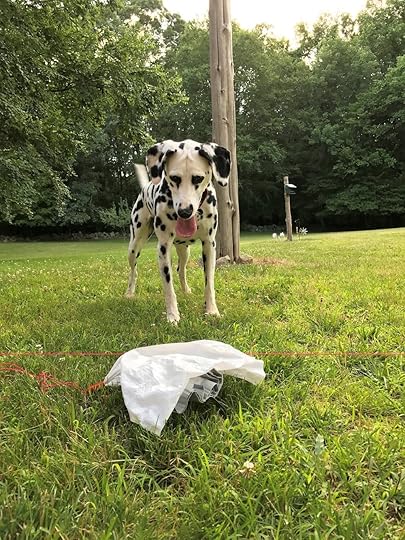
I included the video at the top of this blog because of yet another myth: deaf dogs can't run free. Judea, like Hogan years ago, runs free as she runs the lure course, better known as running the bunny. Pure joy for her and for me!
July 17, 2017
The Mission of Hope
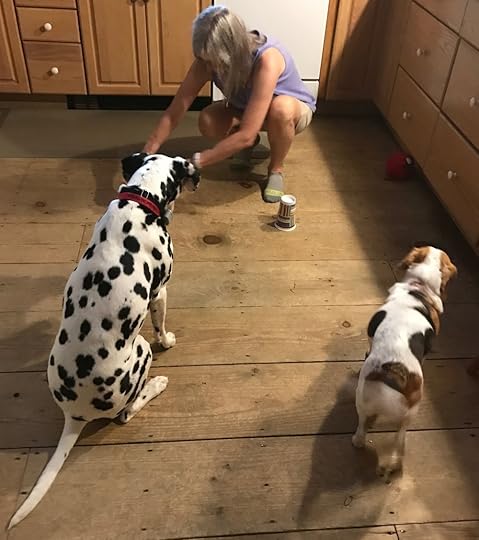
Judea, #deaf #dog, watches intently during a game of the three-cup-shuffle.
I was privileged to have been able to #adopt our Hogan into our family back in 1993 when he was 18 months old. His #deafness wasn't any sort of a concerning thought in bringing him home - we simply adapted our method of communicating with him. #Books, articles, manuals, and videos have been written and produced since that time explaining how to live with a #deaf #dog. These are great and I truly applaud those who are offering #training directions. The fact of the matter is that it is we humans who need to simply shift how we get our message across to our pups. Think about it. Some police academies use German to train their canine partners. Herding experts use various whistle sounds. Animal sports often utilize arm and hand gestures. And, many of us with deaf #dogs use #American #Sign #Language.
Deaf dogs are often destroyed, mistreated, or abandoned. The #myths that they are unable to learn, cannot become wonderful family members, will get hit by cars, will startle more easily, and are prone to aggression are all just that - MYTHS. Each one is untrue and I continue my mission to spread the word that deaf dogs can make loving family members. And, I say family members - not #pets - because our four-legged creations need to be more than the level of a pet. Remember years ago when we could buy "pet rocks?" Exactly! If rocks can be made into pets, what does that make our beautiful #pups (kitties, hamsters, gerbils, etc.) who can feel, respond, learn, cuddle, and love?
Myth #1: Deaf dogs can't learn - FALSE!
In the picture above, my deaf pup, Judea, is watching intently as she learns to find the treat under the cup during the 3-cup-shuffle. She is 95% accurate and successful as she demonstrates how well she learns to children whenever we go out for an appearance or book signing. She has learned many other things as well. Using over 20 American Sign Language words, she understands sit, cookie, come, lay down, drop, get, pick up, hungry, eat, wait, jump, out, and kiss. These are just a few. Hogan's vocabulary was over 70 signs.
[image error]
In this picture Judea has learned very well how to feed herself from the "Bubblegum Machine."
Myth #2: Deaf dogs will get hit by cars - TRUE, but ............
How many of the dogs that are hit by cars in the United States every year are dogs who can hear? Dogs are not by nature aware of the danger of cars and ALL pups need to be kept out of harms way.
Myth #3: Deaf dogs will startle more easily - True and False
The expression "Let a sleeping dog lie," was NOT coined because of deaf dogs but because of all dogs. We must be responsible caregivers and desensitize any and all our pups from being startled whether they are sleeping or awake. I know that I don't like being scared when someone startles me from sleep, deep concentration, or popping out from behind a corner. Teach our pups to know that any circumstance of touch is safe and loving.
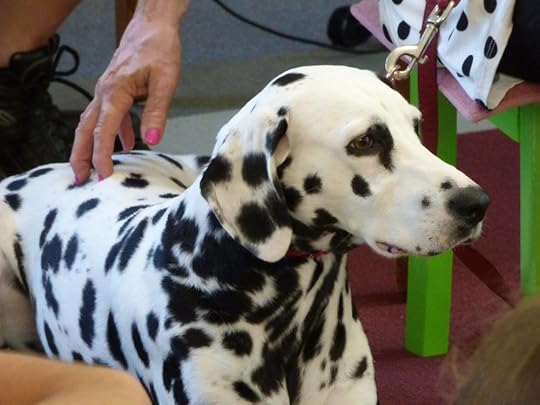
Judea feels safe and loved whenever she is touched. Like all dogs need to be, she has been desensitized to being startled or touched suddenly.
Myth #5: Deaf dogs are more prone to aggression - FALSE
I have had three deaf pups thus far and all three have been loving, gentle creatures who begged for gentle gestures of love and acceptance in return. Additionally, I have had the honor of working with thousands of families internationally with deaf pups and encountered only a handful (if that many) who were in need of redirection and training regarding any type of aggression.
I know that there are more untrue statements about our beloved deaf pups. There are also many more untrue assumptions and discriminations made about various breeds, colors of dogs, etc.
My hope is that Hogan’s journey and his courage to overcome challenges and prejudice continues to give inspiration to anyone, human or pet, that accomplishment, success, and genuine love are truly possible. Through his lifetime of determination, Hogan’s tale offers us the promise that we all are capable of achieving an amazingly “ordinary” life and a life away from isolation. His valor reveals that dreams come true and offers insight into the world of true faith, unconditional love, and endless hope. It is a story that needs to be shared so our deaf pups, all our pups, can be loved as they deserve to be loved.
The mission: to encourage each other to choose hope - anything is possible when we choose hope.
July 3, 2017
On the Road
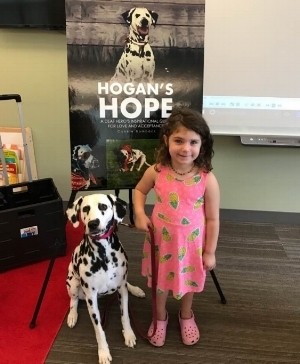
Judea loves hanging out with the children who we meet in our travels.
The learning curve of being a first-time author has certainly been an adventure with many learning experiences. Each event brings its own unique venues, audiences, interests, and approaches. Everyone has been extremely welcoming and warm and seem genuinely intrigued by the notion of deaf dogs and their plight. However, I realize that each one has requirements that are often not anticipated and that I need to plan to bring items that apply to all types of needs - needs that I often never contemplated. But, each is worthwhile and makes the appearance and/or presentation just that much more special and appealing.
I talked about our time at the American School for the Deaf in an earlier blog. It continues to warm my heart and fill my thoughts with glorious sentiments and miraculous moments of children experiencing a deaf pup who understood and responded to them. The smiles and giggles resound in my mind.
I also talked about Camp Gone to the Dogs in Marlboro, VT, where Hogan got to run completely free for the first time ever! Many campers remembered our legendary hero who began the movement in 1993 to save deaf dogs from ultimate destruction merely because they were deaf. He broke the barriers of those untrue myths and championed the ability to achieve and live a "normal" life when none others had gone before him. How wonderful it is to see articles, YouTube videos, and owners with their special family members leading wonderful lives.

Now our journey continued to the Killingworth Farmers Market where Judea, our deaf dog of present, entertains and offers love to the visitors and shoppers. We met many wonderful people who wanted to hear more about Judea and her late brother, Hogan. Meeting folks who have open and accepting minds makes getting out our message of hope so much easier.
We will be revisiting this wonderful atmosphere on July 8th.
(BTW: Judea uses a gentle leader instead of a regular collar in order that she is gently lead instead of experiencing a pull on her tender neck. She does NOT wear or need a muzzle as some often mistake this type of collar.)
[image error]
Of course, sharing the space with author, D. Margaret Hoffman, of Saving Our Lives, adds an extra-special element of fun. Dawn is articulate and creative and has the amazing ability to bring out the best of anyone's ability to write their story. I know for sure that when I was feeling as if I couldn't make it, her writing spurred me on with "I can do this!"
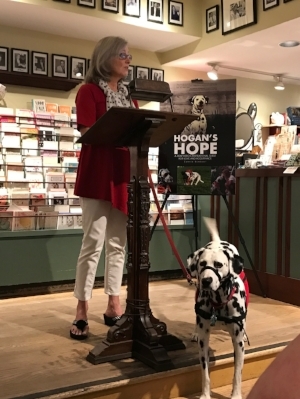
Being invited to RJ Julia Booksellers was indeed a compliment. I joined three other pet-loving authors and we all shared our books. I decided to add a reading which left the attendees on the edge of their chairs to find out what happens next. A very special addition to this event was my friend, Eileen Baker! She had accompanied me to the American School for the Deaf and interpreted for me in American Sign Language. My belief in using ASL with my dogs instead of adaptations of hand signals is that many people will be able to talk with my deaf pups naturally. Sure enough! A deaf gentleman was a guest that evening and Eileen came to the rescue by interpreting the entire presentation for him. Afterwards, he talked with Judea and was thrilled that she understood almost everything he said. It doesn't get much better than that!!
On June 26th, we visited the Ocean City Public Library in Ocean City, New Jersey. This was "a dream come true." I spent all, truly all, of my summers as a youngster with my grandparents who lived in OCNJ and continued to vacation for most of my adult life with my immediate family. This vacation has grown into fabulous, memory-making family reunions with folks coming as far away as Australia some years.
When I approached Julie Brown, the library's program director, about the possibility of presenting and signing, she greeted me with immediate and genuine enthusiasm, excitement and reception. The evening was a huge success in which the entire audience became engaged and interested in learning about deaf dogs, their plight, and the hope - hope for us all, no matter what.
The following is a review of their publicity for the event which gained recognition as one of the best events in Ocean City. Wow! I am humbled.
Meet the Author Hogan's Hope Book Signing has been published on allevents.in and listed among the best events in Ocean City.
Take a quick look at the event below:

Meet the Author Hogan's Hope Book Signing
Thu Jul 06 2017 at 6:30 pm
Ocean City, NJ
Our journey continues with a reappearance at the Farmers Market at Parmelee Farm on Saturday, July 8, 10:00 AM to 1:00 pm.
Then, we are off to Breakwater Books in Guilford, CT, on July 22, 11:00 AM to 2:00 PM. This will be a fun and interactive day with visitors to the Guilford Green. The store's owner, Liza, can't be friendlier or more welcoming.

July 29th will have us at Barnes and Noble in West Hartford, CT about 11:00 AM along with author Shawn Flynn. Our proceeds from this event will benefit the CT Humane Society where Hogan began his days of being rescued. It seems very fitting that he will be able to give back a piece of what was given to him.
My hopes are that we can continue to schedule places where we can make the dollar or two that we get when selling our book, Hogan's Hope: A Deaf Hero's Inspirational for Love and Acceptance, so that we can donate most of these proceeds to the non-profit organizations that are hosting our events. We look forward to any possibility and suggestions.
Our mission: Giving back. Accepting. Loving. Holding Hope though any challenge.
June 7, 2017
A Day at Camp Gone to the Dogs
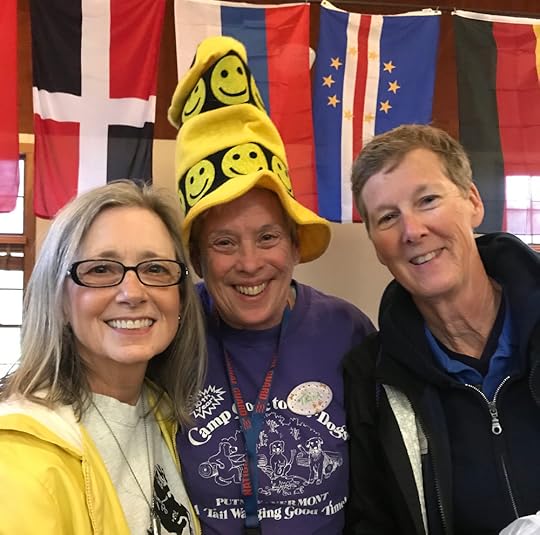
Connie Bombaci with Trina Bianchi and Mare Potts. Much appreciation to these very special dog lovers for helping and allowing us return to the place where Hogan got to realize his hope to run free.
Who would have ever imagined that Hogan's Hope would return to the event that made it possible for Hogan, a deaf dog, to run free for the very first time? Sure, Hogan ran in his fenced yard or on a 30' long line when outside the safety of his home. But, it wasn't until he was introduced to lure coursing, better known as running the bunny, that he was able to run the entire length of a massive field and feel the heart-pounding, full-throttle speed of the chase. Trina, the wonderful lady in the center adorned with her smiley hat, reassured me back in 1996 to "Let him try. He'll come back. Promise. Hogan will come back." Not being able to recall Hogan if his back was turned toward me, my husband and I both feared that he'd just keep on going. When Jim and I entered the dining hall before our author presentation, Hogan may not have been with us physically but he was definitely there in spirit. Several of the campers remembered him well from 21 years ago. Wow! Hogan's legacy lives on.
I share an excerpt from his book, Hogan's Hope: A Deaf Hero's Inspriational Quest for Love and Acceptance --
"It looked like enormous fun, and I was certain that all three of our pups would have a grand time playing this new sport. But Hogan and Georgia couldn’t be off leash because they couldn’t hear the call of “come” if their backs were turned towards me. Furthermore, when they were off leash, such as during agility, they could always see me and were close enough for me to snatch up the strap attached to their collars. Each morning and evening we would all stand on the sidelines watching and cheering on the pup who was focused on capturing the prey. Hogan barked more than he ever had, and I am sure he wanted
to chase that bunny down and across the meadow.
Jim and I continued to watch dogs dashing on the lure course and yearned for Hogan to have a shot at this exhilarating sport. We stood on the sidelines while Hogan barked ceaselessly and bounced up and down. He craved a piece of the action.
“Jim, do you think we could let him try this?” I asked. “You could stand at the far end of field just in case he tried to keep going.”
Jim shook his head with hesitancy when he replied, “I don’t know. He could really get a head start on me and then he’d be gone.”
“I could ask some of the other campers to help out. What do you think?”
Trina was a kind woman who partnered with her husband to make this opportunity available to the campers. While she stood at only 5 feet in height, her heart was “bigger than all outdoors,” and she offered it to anyone who earnestly loved their pets. What Jim and I didn’t know was that she had been watching us from her post at the starting line. Finally, she touched her husband’s shoulder and quietly spoke into his ear. Then, leaving his side, she came over to us and simply said, “Let him try. He’ll come back. I promise. Trust me. He’ll come back.”
Jim and I looked at each other with a mix of worry and hope. After a moment’s hesitation, we agreed to give Hogan a chance. Jim handed off India and Georgia to other campers who were willing to help and enthused to see just what Hogan would do. He then jogged his way to the far end of the field. I carefully listened to Trina’s directions. As she prepared me on how to handle the pup during his release and finish, the crowd of campers on the knoll to the right of the field grew larger. The knowledge of Hogan’s deafness had spread across camp throughout the week, and many campers were astounded at his ability to learn, perform, and succeed. They also witnessed the unyielding bond and devotion between Hogan and me. Silence replaced the roar of their usual cheering, and many held their hands over their mouths in great anticipation.
Tom asked, “Are you ready, Connie?”
“I don’t know about me, but I know Hogan’s ready to go,” I answered as I unhooked his leash and held onto his collar with a white-knuckle grip.
“When the bunny comes around the wheel to the first pulley, let him go,” Tom repeated Trina’s earlier instructions.
“Get ready.”
As soon as the motor started and the “bunny” came whipping around that big wheel and first pulley, I released my grasp. Hogan was free. He ran faster than he ever had, and he was determined to catch the prize. What unrestrained freedom! The profound silence of the group remained unbroken. I had tears streaming down my cheeks. Jim had to wipe his face with his sleeve. There literally wasn’t a dry eye to be found. Hogan dashed at each corner and rushed across every stretch.
He ran the entire course staying sharply focused every inch of the way. As he rounded the last bend and entered the final lap, I positioned myself to pick him up when the bunny came to a stop.
Trina called out over the sound of the motor, “Let him catch it so he feels successful! He has to win.”
Hogan was elated to capture his prey which he shook ferociously. The crowd’s silence broke into a jubilant uproar of applauding and hollering. Hogan had shredded the plastic bag by the time I signed for him to “drop.” The swarm of campers was stunned that he dropped his trophy. He unbelievably obeyed and dropped “the bunny.” Well, almost obediently. He couldn’t resist one last try to get it as I grappled to lead him away. Hogan came back. He came back just like Trina promised, having had the absolute best time of his life running free.
I knew that his heart pounded, and he panted with his tongue hanging as far out as it possibly could. The muscles in his entire body had gone flat out, and every drop of his energy was drained. There was no better feeling. Hogan got to go again after a rest, and he ran with just as much thrill of the chase. He was on top of the world."
© 2017 Connie Bombaci
Run free, Hogan! Always run free knowing we love you!
May 31, 2017
BookExpo 2017

Hogan's Hope will be at the 2017 Book Expo located in the Javits Center, New York City! We are new at all this but are excited at making the leap of faith that this may hold the promise of exposure to a bigger market. Our wonderful Brian Jud from Association for Publishers and Special Sales (APSS) has been a mentor and advisor during some of my marketing and his counsel is greatly needed and appreciated.
Having my book on display at a big show is quite exciting yet nerve wracking at the same time. I am uncertain if I am doing enough or missing the mark. I am keeping my fingers crossed that I will learn from this new experience and be better prepared to know the ropes as I move forward with my first book, Hogan's Hope: A Deaf Hero's Quest for Love and Acceptance.
I wish all the new authors well!
May 27, 2017
Hogan's Hope Inspires Deaf Students

On Wednesday, May 24th Connie Bombaci and her deaf dog, Judea, visited the students at the American School for the Deaf to talk to the young learners about her newly published book titled “Hogan’s Hope: A Deaf Hero’s Inspirational Quest for Love and Acceptance.” Hogan was a deaf dog who Connie rescued from being destroyed as most deaf animals are doomed. After learning over 70 signs in ASL, he prevailed and soared to success – always keeping hope as his guiding light.
The students at the American School for the Deaf were very privileged to have a visit from Judea the Dalmatian. What a wonderful treat this was for our students. When they found out that Judea was Deaf, just like them, they were completely enthralled by her and thrilled by being able to talk with a pet who could understand what they were saying through American Sign Language.
Judea showed us how smart she is. She pushed a bone shaped lever and released food from a dispenser to feed herself. She also identified which cup had a treat hidden under it after Connie, Judea’s “mom”, shuffled three different cups. Judea was such a calming influence on the children. She loved all the attention and pets the children were more than eager to give her.
The students were truly energized with excitement and expectation. The atmosphere in the room was magical and the promise of hope shined!
Librarian Maria Jacovino: "Judea’s visit was extra special for our children, but I would recommend her visiting any school environment. The book, Hogan's Hope: A Dead Hero's Inspirational Quest for Love and Acceptance, will be in the library soon."
Today's blog is an adaptation of an article in the ASD's weekly newsletter. Thank you to everyone at the American School for the Deaf for such an amazing day.
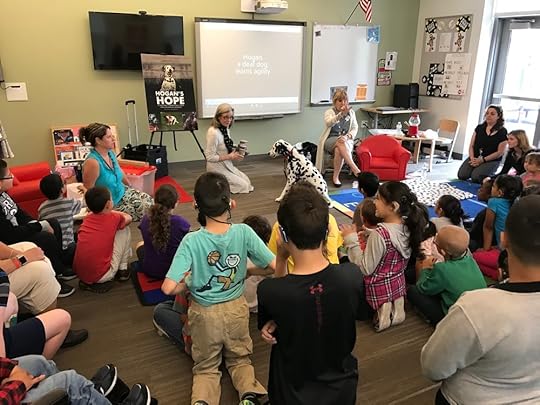
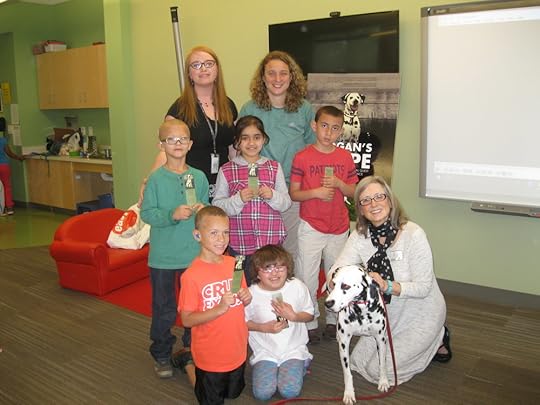
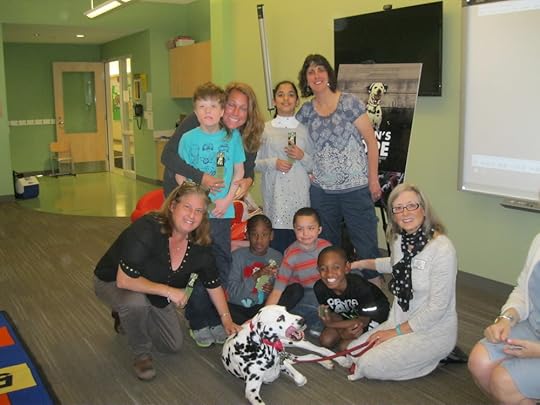
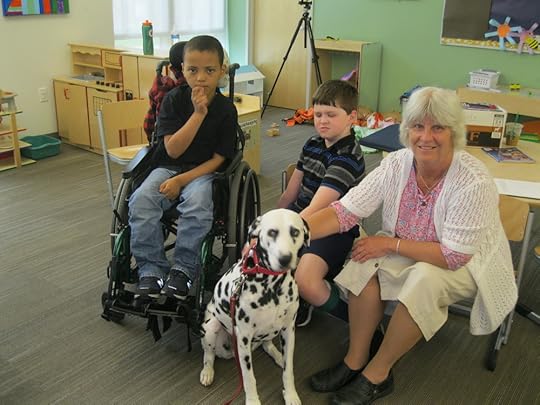
May 9, 2017
Blessings
All the words and the message for today's #blog are in this video produced by a former student of Haddam-Killingworth High School. Our #blessings are immeasurable and we share it all with all #God's #creatures, great and small. Several of the Holiday Shows benefited our #pets, the #Humane Society, and wildlife organizations.
A short documentary made by Kristie Kaminski (former #Haddam-Killingworth High School student) as her Senior Thesis Project at Endicott College. It tells the story of the #HKTV Holiday Show.
youtube.com



